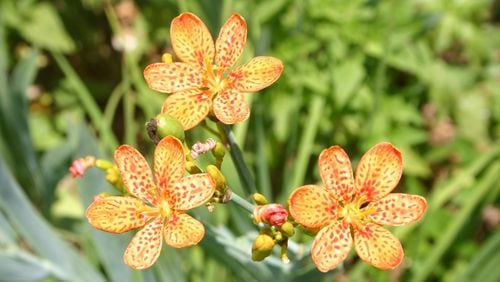Q: Someone gave us a basket full of blackberry lily seeds and pods. When and how is the best time to plant them? Michael Hoffer, Dahlonega
A: I planted a couple dozen seeds last spring and about half of them came up, which was to be expected. I simply dug an inch-deep hole for each shiny black seed and dropped them in. The ones that came up were six inches high this fall: healthy but too small to make a flower stem. The leaves have turned brown for winter but they will reappear in spring. I imagine they will be big enough to flower next year.
Q: We have an old water oak in our front yard that the Extension service tells us is in decline. For the past three years, there has been a noticeable diminishment of leaves on the tree. What can be done? Rebecca Byrd, email
A: There are ways to reinvigorate a declining tree but you need the eyes of a knowledgeable arborist to help you make the decision on whether it's worth doing for this particular tree. Go to the website of the Georgia Arborist Association (www.georgiaarborist.org) and select an ISA certified arborist to come take a look at your situation.
Q: I followed your directions on reseeding a fescue lawn and it turned out lush and beautiful. The only problem is that clover is all over. Should I use a weed killer to eradicate it? Terrill Wilson, Lilburn
A: The general rule is to wait until you have mowed the lawn at least a couple of times before it's ready to have weed killer sprayed on it. You'll have plenty of time to control clover later this winter. There's no need to hurry now.
Q: I seeded fine fescue in September and the lawn looks great. When using a LusterLeaf moisture meter, what is the range needed for watering fescue grass? Jim Barbaree, Cobb County
A: Inexpensive moisture meters like this are not really designed for use outdoors. They are best used for houseplants. Use one to compare moisture readings over a period of time. You can get some idea of what the numbers on the meter mean by first putting it in a pot filled with soggy potting soil and comparing that to what you get when the meter is put into a pot filled with completely dry potting soil.
For your lawn, you’ll get the best information by using a trowel to pull a slice of earth out of the ground to see if it is dry or moist. For your young lawn, the top couple of inches of soil should be kept moist, but not soggy. Use local rainfall amounts plus irrigation to insure the lawn gets 1/4 inch of water per week in winter. When hot weather rolls around, your lawn will need an inch of water per week.
Q: Where did my holly berries go? It was loaded and now it is bare! Phyllis Lovelace, email
A: My bet is that a flock of birds visited when you weren't around. I've seen several robins at my birdbath recently. Robins, woodpeckers, and cedar waxwings love to eat holly berries.
About the Author






